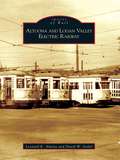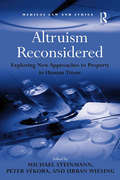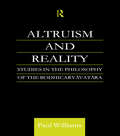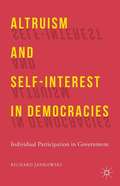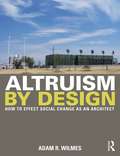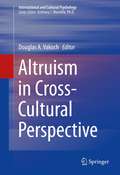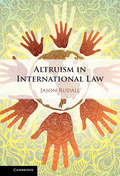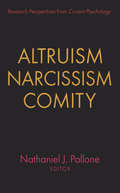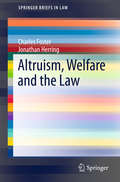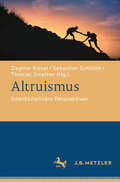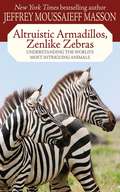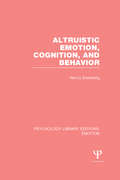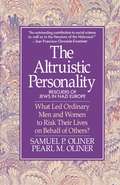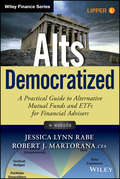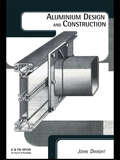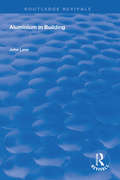- Table View
- List View
Altoona State Investment Board: July 2012
by Josh Lerner Nathaniel BurbankConsiders the decision faced by state pension fund manager Rod Calhoun as he decides whether to invest $200 million in Bain Capital's eleventh global buyout fund: Bain Capital Fund XI. For the fund, Bain was offering its limited partners a choice between three different fee structures: first, a "conventional" fee structure of a 1.5% management fee with 20% carried interest and a 7% preferred rate of return; second, a 1% management fee with 30% carried interest and a 7% preferred rate of return; or third, a 0.5% management fee, 30% carried interest, and a 0% preferred rate of return. Should Calhoun invest in Bain? If he should, which fee structure should Calhoun choose?
Altoona and Logan Valley Electric Railway
by Leonard E. Alwine David W. SeidelDating back to 1882, the Altoona and Logan Valley Electric Railway has humble origins, but it quickly became a viable transportation system serving the city of Altoona. Often referred to as the Logan Valley, the railway employed 300 people, transported 11.5 million passengers a year, and traveled 7,220 scheduled route miles a day until economic conditions forced the line to discontinue service on June 2, 1954. Altoona and Logan Valley Electric Railway documents the history of a streetcar network that served the employees of the Pennsylvania Railroad as well as the community. Through 200 images and informed narrative, this book retraces the history of the Altoona and Logan Valley Electric Railway and its successor, the Logan Valley Bus Company.
Altos Ventures (A)
by Jo Tango Alys FerragamoIn December 2012, Altos Ventures General Partners Han Kim, Anthony Lee, and Ho Nam met to discuss the future of the firm. Altos had already adjusted its strategy multiple times. It began as a U.S.-focused venture capital investor whose first two funds were backed by a sole limited partner, a South Korean financial conglomerate. In late 2001, the partners made their first transformative decision, raising a fund from traditional institutional LPs to focus on bootstrapped technology companies. In 2008, Altos again refined its strategy, this time to fund similar capital-efficient companies but with more "explosive growth" potential. Now, in 2012, the firm was running out of capital and did not have the realized track record to raise another traditional institutional fund. They considered two options: raise a South Korea-focused VC fund or offer more co-investment opportunities to LPs through a "mini" fund. What should Altos do to stay afloat?
Altos Ventures (B)
by Jo Tango Alys FerragamoIn December 2021, Han Kim, Anthony Lee, and Ho Nam reflected on how far they had come since 2012. This B case provides an update on Altos Ventures' decision-making and performance since the events presented in the A case.
Altruism Reconsidered: Exploring New Approaches to Property in Human Tissue (Medical Law and Ethics)
by Urban Wiesing Peter SýkoraAs the use of human body parts has become increasingly commercialized, a need has arisen for new approaches to regulation that moves beyond the paradigm of altruism. During the course of this discussion, the notion of property has become a key concept. Focusing on practical and conceptual perspectives, the multidisciplinary group of authors, which includes specialists in philosophy, law, sociology, biology and medicine, have come together with practicing lawyers to consider both legal provisions and patterns of regulation in countries across Europe. Identifying divergences between different legal traditions, the authors explore various conceptual models which could be used to improve and to guide policy making. With this twin focus on practical and conceptual perspectives, this volume sets the standard for a detailed and innovative discussion of issues surrounding the regulation of research on human tissue.
Altruism and Reality: Studies in the Philosophy of the Bodhicaryavatara (Routledge Critical Studies in Buddhism)
by Paul WilliamsBrings together Paul Williams' previously published papers on the Indian and Tibetan interpretations of selected verses from the eighth and ninth chapters of the Bodhicaryavatara.
Altruism and Self-Interest in Democracies
by Richard JankowskiIndividuals have little incentive to vote, acquire political information or contribute campaign funds, because their vote has very little chance of affecting the outcome of an election. Jankowski offers an explanation and evidence for political participation based on the assumption that most individuals are weakly altruistic. Other proposed explanations of political participation (civic duty and expressive behavior) are not supported by the evidence, or fail to explain the many different forms of political participation, such as the acquisition of political information. Evidence is presented that liberals and conservatives are equally altruistic. Therefore, an explanation of why liberals and conservatives differ in their support of various government programs to help the needy is presented. Jankowski's analysis examines both the electoral and post-electoral phases of representative democracy.
Altruism and Workers' Remittances: Evidence from Selected Countries in the Middle East and Central Asia
by Jacques Bouhga-HagbeA report from the International Monetary Fund.
Altruism by Design: How To Effect Social Change as an Architect
by Adam R. WilmesAltruism by Design: How to Effect Social Change as an Architect is meant to prepare the individual designer – whether a student or practicing professional – for a career dedicated to serving communities in need through design and construction. It will help you understand the complexities, opportunities, and benefits of creating architecture that promotes social equality and community so that you can make a difference. What you'll learn: -How community-based studios can respond to natural disasters and economic conditions-How to build what you design-How to develop relationships with non-traditional clients-How to structure your career to be dedicated to social change and sustainable design-How to discover funding opportunities for projects in a not-for-profit firm-How to consider moral and financial aspects of your practice-How you can collaborate with other design professions to determine the future of the built environment Featuring detailed case studies, including work by Studio 804 and Pyotak Architects, and more than 100 color images; this book is essential reading for providing you with a viable path to altruistic design.
Altruism in Cross-Cultural Perspective (International and Cultural Psychology)
by Douglas A. VakochAltruism in Cross-Cultural Perspective provides such a scholarly overview, examining the intersection of culture and such topics as evolutionary accounts of altruism and the importance of altruism in ritual and religion. The past decade has seen a proliferation of research on altruism, made possible in part by significant funding from organizations such as the John Templeton Foundation. While significant research has been conducted on biological, social, and individual dimensions of altruism, there has been no attempt to provide an overview of the ways that altruistic behavior and attitudes vary across cultures. The book addresses the methodological challenges of researching altruism across cultures, as well as the ways that altruism is manifest in difficult circumstances. A particular strength of the book is its attention to multiple disciplinary approaches to understanding altruism, with contributors from fields including psychology, anthropology, sociology, biology, communication, philosophy, religious studies, gender studies, and bioethics.
Altruism in International Law
by Jason RudallMuch emphasis has been placed on the role that individualism, self-interest and reciprocity have in the formation and function of international legal rules. Rarely has attention been given to the presence of altruism in legal systems, let alone the international legal system. In a study that is the first of its kind in international legal scholarship, Altruism in International Law explores and analyses the emergence of altruistic legal relationships between states and people in other countries. The book also argues that the impulse for the emergence of these relationships is a cosmopolitan ideology, which co-exists with a persisting statist ideology, among the major actors in international law-making processes. Further still, the book reveals that individualistic legal norms are more often manifested as strict rules while altruistic legal norms find expression in flexible standards. This suggests that there is a connection between substance and form in international law.
Altruism, Narcissism, Comity
by Nathaniel J. PalloneHow does the sense of basic fairness--or selflessness versus selfishness--arise? How is it exhibited behaviorally? How is it maintained? Few topics hold more contemporary significance or have proved more elusive to specification in precise scientific terms. Current research perspectives on altruism, narcissism, and comity by distinguished behavioral scientists from around the world were brought together in a special issue of Current Psychology (Summer 1998) and are offered here in a useful compendium.Chapters and contributors include: "Equity, Justice, and Altruism" by Graham F. Wagstaff; "Reactions to the Fate of One's Brainchild After Its Disclosure" by Sidney Rosen and Shannon Wheatman; "Need Norm, Demographic Influence, Social Role, and Justice Judgment" by Helen E. Linkey and Sheldon Alexander; "Adaptive and Maladaptive Narcissism" by Robert W. Hill and Greg Yousey; "Perceptions of Self-Oriented and Other-Oriented Help-Providers" by Mark A. Barnett, Guy D. Vitaglione, Jeffrey S. Bartel, Birgit S. Valdez, Lee Ann Steadman, and Kimberly K. G. Harper; and "Pathological Narcissism and Serial Homicide" by Louis B. Schlesinger. Altruism, Narcissism, Comity will benefit students, researchers, and practitioners in the psychological sciences, sociology, political science, philosophy, law, and other disciplines concerned with the nature of selflessness, heroism, justice, and their variants.
Altruism, Welfare and the Law (SpringerBriefs in Law #0)
by Charles Foster Jonathan HerringThis book is an assault on the notion that it is empirically accurate and legally and philosophically satisfactory to see humans as atomistic entities. It contends that our welfare is inextricably entangled with that of others, and accordingly law and ethics, in determining our best interests, should recognise the central importance of relationality, the performance of obligations, and (even apparently injurious) altruism.
Altruism: The Power of Compassion to Change Yourself and the World
by Matthieu RicardThe author of the international bestseller Happiness makes a passionate case for altruism--and why we need it now more than ever.In Happiness, Matthieu Ricard demonstrated that true happiness is not tied to fleeting moments or sensations, but is an enduring state of soul rooted in mindfulness and compassion for others. Now he turns his lens from the personal to the global, with a rousing argument that altruism--genuine concern for the well-being of others--could be the saving grace of the 21st century. It is, he believes, the vital thread that can answer the main challenges of our time: the economy in the short term, life satisfaction in the mid-term, and environment in the long term. Ricard's message has been taken up by major economists and thinkers, including Dennis Snower, Amartya Sen, Joseph Stiglitz, and George Soros.Matthieu Ricard makes a robust and passionate case for cultivating altruistic love and compassion as the best means for simultaneously benefitting ourselves and our society. It's a fresh outlook on an ardent struggle--and one that just might make the world a better place.
Altruismus: Interdisziplinäre Perspektiven
by Sebastian Schmidt Dagmar Kiesel Thomas SmettanAltruismus scheint im Alltagsverständnis seinen uneingeschränkt positiven Ruf als ebenso wünschenswerte wie seltene Tugend verloren zu haben und durch ein Ethos des Eigennutzens ersetzt worden zu sein. Angesichts globaler Krisen wie dem Klimawandel, großer Flüchtlingsbewegungen, Kriege und Armut ist die Bereitschaft zur Verhaltensänderung bzw. zum Verzicht zugunsten kommender Generationen oder hilfsbedürftiger Menschen weniger selbstverständlich als das Phänomen der psychologischen Reaktanz und die Weigerung, Einschränkungen der persönlichen Freiheit oder des Konsums hinzunehmen. Zeitgenössische Ethikerinnen und Ethiker müssen sich demnach mit der Frage nach der Motivation für ein Handeln auseinandersetzen, das in erster Linie nicht dem eigenen Wohl, sondern dem Wohl anderer dient. In diesem Sinne beleuchtet der vorliegende Band das Thema Altruismus in seinen verschiedenen, wechselseitig aufeinander verweisenden Facetten: Wie ist das Wesen altruistischen Handelns zu bestimmen? Liegt Altruismus in der Natur des Menschen? Lässt sich Altruismus widerspruchsfrei in verschiedene Ethiktypen einordnen? Wie verstehen verschiedene philosophische Traditionen und Religionen den Altruismus? In welchem Verhältnis steht der Altruismus zum guten Leben? Und: Wie ist altruistisches Handeln motiviert? Da diese Fragen in verschiedenen Fachwissenschaften und mit unterschiedlichen Perspektivierungen gestellt werden, ist dieser Sammelband interdisziplinär konzipiert: Philosophie und Religionswissenschaft kommen ebenso zu Wort wie Verhaltensökonomie und Evolutionsbiologie. Auch anthropologische, soziologische und psychologische Zusammenhänge werden beleuchtet. Dementsprechend richten sich die hier versammelten Aufsätze an ein sehr breit gefächertes akademisches Publikum, aber auch an eine interessierte öffentliche Leserschaft außerhalb des universitären Kontexts. Mit Blick auf diese Zielgruppen führen die einzelnen Beiträge in das jeweilige Thema ein und präsentieren gleichzeitig eine eigene Forschungsposition der Autorin bzw. des Autors.
Altruistic Armadillos, Zenlike Zebras: Understanding the World's Most Intriguing Animals
by Jeffrey Moussaieff MassonFrom the elegant, lithe, and yes, friendly cheetah to the diminutive and faithful sea horse, and from the giant and surprisingly warlike hippopotamus to the majestic gorilla, animals have long fascinated humans. In this appealing book, Jeffrey Moussaieff Masson draws from his wealth of knowledge and a lifetime of fascination with the animal kingdom to present little-known facts and thorough explanations for behaviors of animals both familiar and lesser-known. Presented from A to Z, each entry is accompanied by a beautiful, full-color photograph. Readers will learn from someone who knows these animals and loves them as much as you do.
Altruistic Emotion, Cognition, and Behavior (Psychology Library Editions: Emotion)
by Nancy EisenbergOriginally published in 1986, this book was an effort to integrate thinking and research concerning the role of emotion and cognition in altruistic behaviour. Prior to publication there was a vast body of research and theorizing concerning the development and maintenance of prosocial (including altruistic) behaviour. This book focusses primarily on a specific set of intrapsychic factors involved in prosocial responding, especially emotions and cognitions believed to play a major role in altruistic behaviour. In the final chapters these intrapsychic factors are also discussed in relation to a variety of other relevant factors including socialization and situational influences on altruism.
Altruistic Personality
by Samuel P. OlinerWhy, during the Holocaust, did some ordinary people risk their lives and the lives of their families to help others--even total strangers--while others stood passively by? Samuel Oliner, a Holocaust survivor who has interviewed more than 700 European rescuers and nonrescuers, provides some surprising answers in this compelling work.
Altruistic Personality
by Samuel P. OlinerWhy, during the Holocaust, did some ordinary people risk their lives and the lives of their families to help others--even total strangers--while others stood passively by? Samuel Oliner, a Holocaust survivor who has interviewed more than 700 European rescuers and nonrescuers, provides some surprising answers in this compelling work.
Altruistically Inclined?: The Behavioral Sciences, Evolutionary Theory, and the Origins of Reciprocity
by Alexander J. FieldAlexander J. Field is the Michel and Mary Orradre Professor of Economics at Santa Clara University.
Alts Democratized
by Jessica Lynn Rabe Robert J. MartoranaA Comprehensive Review of the Liquid Alts Market and How '40 Act Products Can Enhance Client PortfoliosLiquid alternatives give investors access to hedge fund strategies with the benefits of '40 Act products: lower fees, higher liquidity, greater transparency, and improved tax efficiency.Alts Democratized is a hands-on guide that offers financial advisors and individual investors the tools and analysis to enhance client portfolios using alternative mutual funds and ETFs. Well-grounded in research and replete with more than 100 exhibits of Lipper data, Alts Democratized profiles the top ten funds in each of the eleven Lipper liquid alt classifications. This includes total net assets, fund flows, risk and return metrics, and the factor exposures that drive performance and help explain correlations to various forms of beta. Jessica Lynn Rabe and Robert J. Martorana, CFA, combine this research with a comprehensive framework for fund selection and portfolio construction to enhance the asset allocation process, facilitate portfolio customization, and manage client expectations.In addition, the book includes functional perspectives on issues pertinent to financial advisors such as fees, client suitability, and volatility management. This helps advisors apply the concepts to portfolios and offer actionable investment advice. The authors also interviewed executives at leading wealth management firms to provide color on industry trends and best practices.The companion website provides ancillary materials that reinforce and supplement the book, including:The authors' top ten takeawaysClassification cheat sheetPortfolio construction guide (full color)Talking points for clientsQ&A on liquid altsPresentation with all 118 exhibits from the book (full color) Alts Democratized comprises a complete resource for the advisor seeking new sources of alpha, diversification, and hedging of tail risks.
Altyd somer (Romanza)
by Annetjie Van TonderRicardo kom bied werkwinkels oor bonsaikuns by Philna se oupa se kwekery aan. Die bonsaimeester maak haar subtiel die hof en wen onherroeplik haar hart. Maar wie is die vrou en seun in die foto wat hy oral saam met hom dra?
Aluminium Bahrain (Alba): The Pot Line 5 Expansion Project
by Aldo Sesia Benjamin C. EstyIn September 2002, Aluminium Bahrain (Alba) needed to decide how to finance its proposed $1.7 billion pot line. The company's financial adviser, Taylor De-Jongh (TDJ), had recommended Alba employ a multisourced financing strategy using as many as five sources of debt from international, regional, and local capital pools. TDJ believed that the strategy would generate competition among the lenders which, in turn, would save Alba millions in financing costs. But the multisourced financing strategy went against the grain of typical project financings in the Middle East and was not without its risks. Alba management must decide how many financing sources to use, which ones, and how much to get from each one. If the market rejects the multisourced financing strategy, the project might become tainted, which could jeopardize Alba's long-term growth objectives.
Aluminium Design and Construction
by John DwightProvides a practical design guide to the structural use of aluminium. The first chapters outline basic aluminium technology and the advantages of using aluminium in many structural applications. The major part of the book deals with structural design and presents very clear guidance for designers, with numerous diagrams, charts and examples.
Aluminium in Building (Routledge Revivals)
by John LaneFirst published in 1992. Aluminium is a relatively new material, first used on a commercial basis just over 100 years ago. Today it has taken its place alongside other traditional materials as an established building element. In this variable reference source, John Lane discusses the history and development of aluminium usage in the building industry. Its characteristics of strength, lightness and durability, coupled with easy formability, make it and ideal medium for this market. The first section of this book is a general discussion of the metal, covering such areas as its properties, alloys, fabrication, joining and finishing. The second part details the aspects of aluminium which are of particular importance in construction, while the final section highlights some of its major uses in architecture and building. The text is amply illustrated with diagrams and photographs, and the appendices provide the reader with comprehensive details of relevant standards and contact addresses.

